
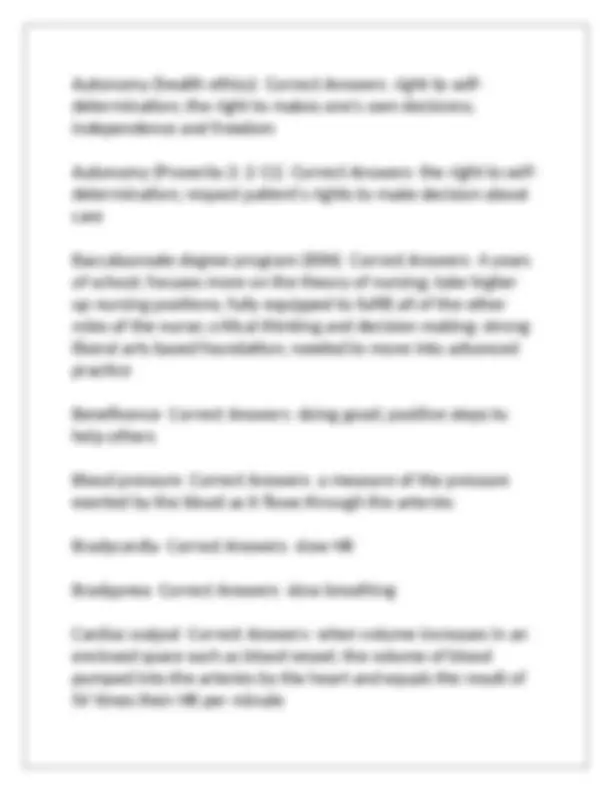
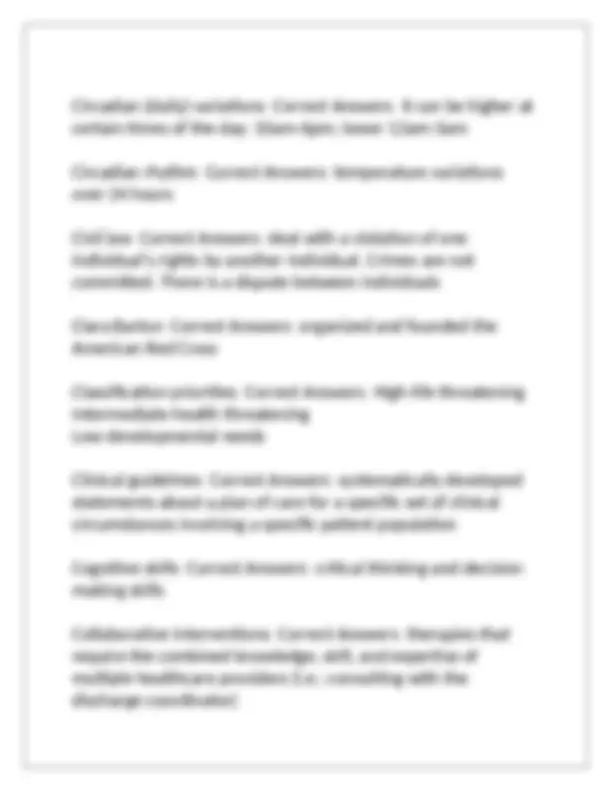
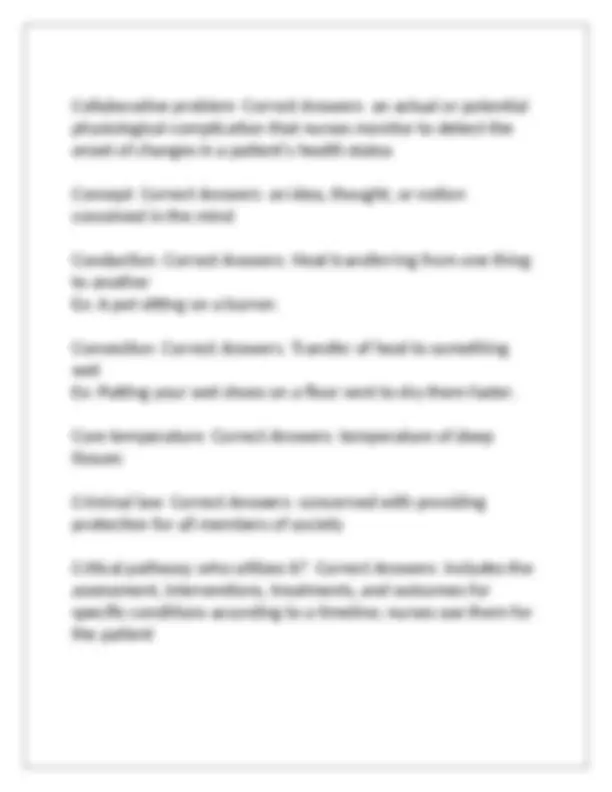
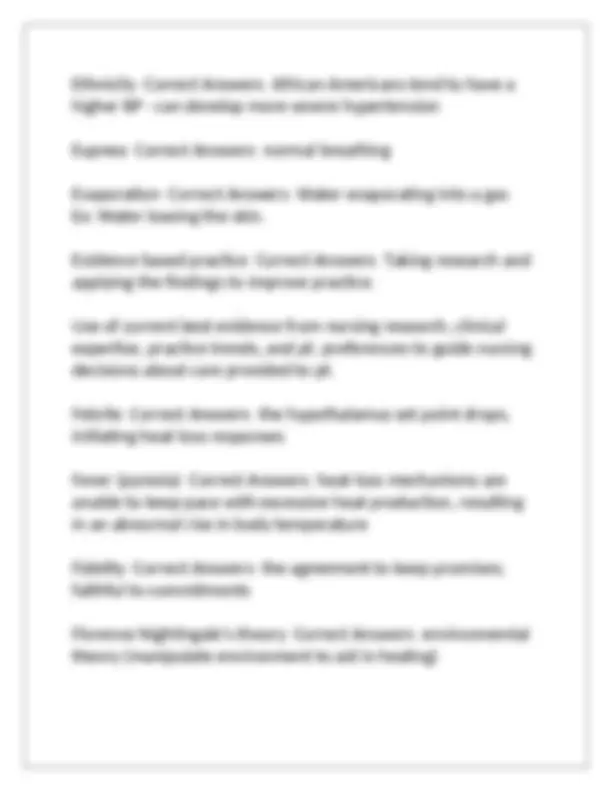
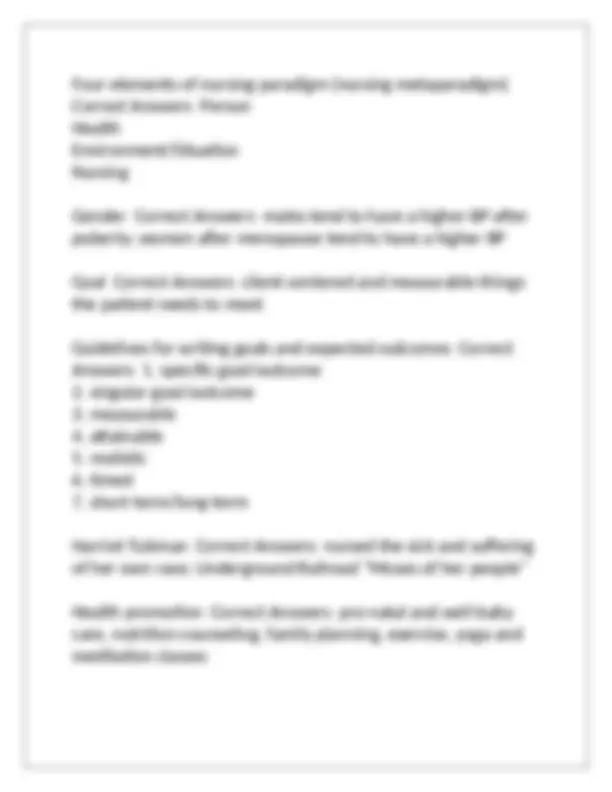
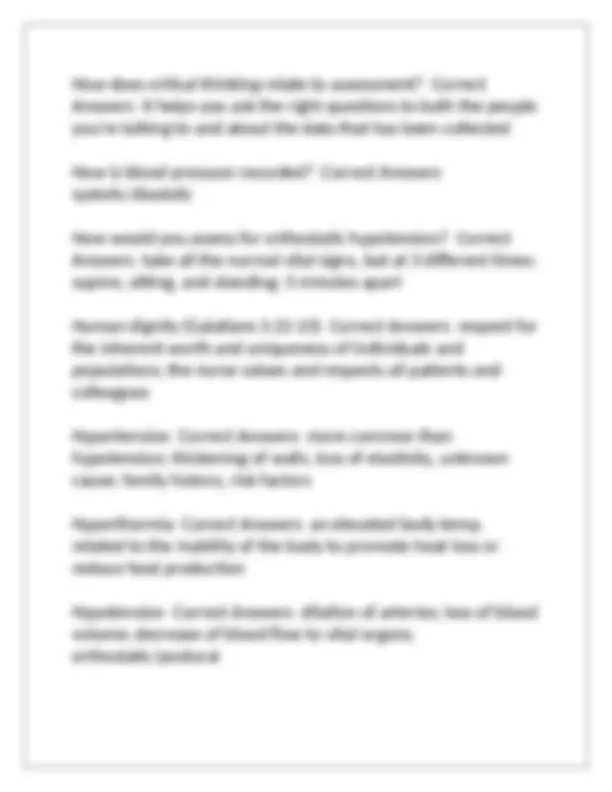
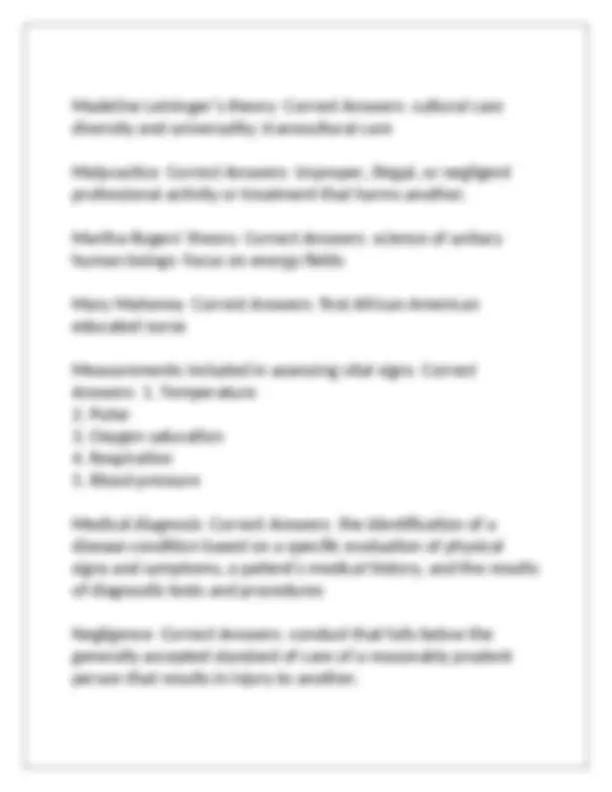
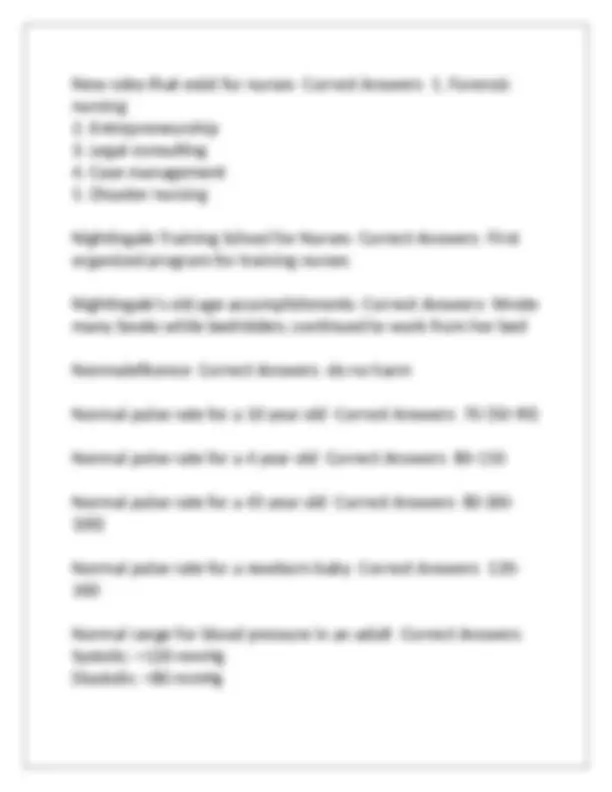
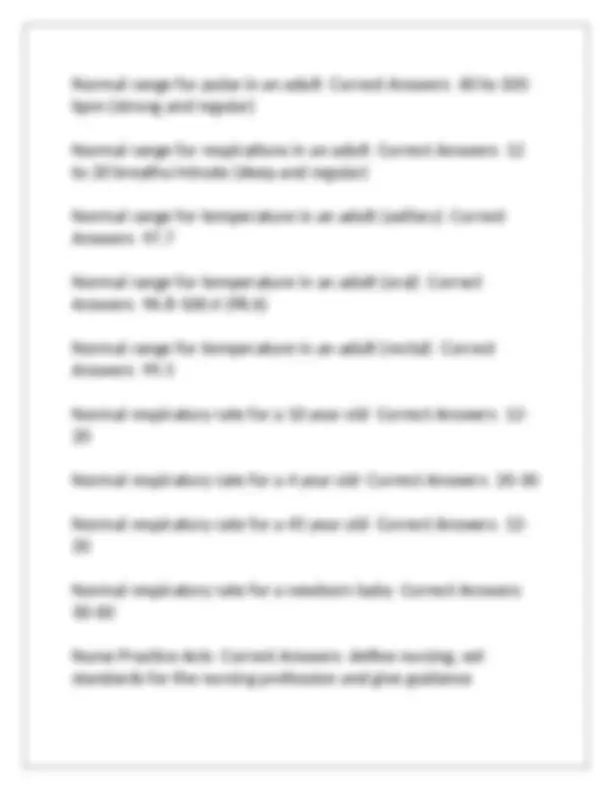
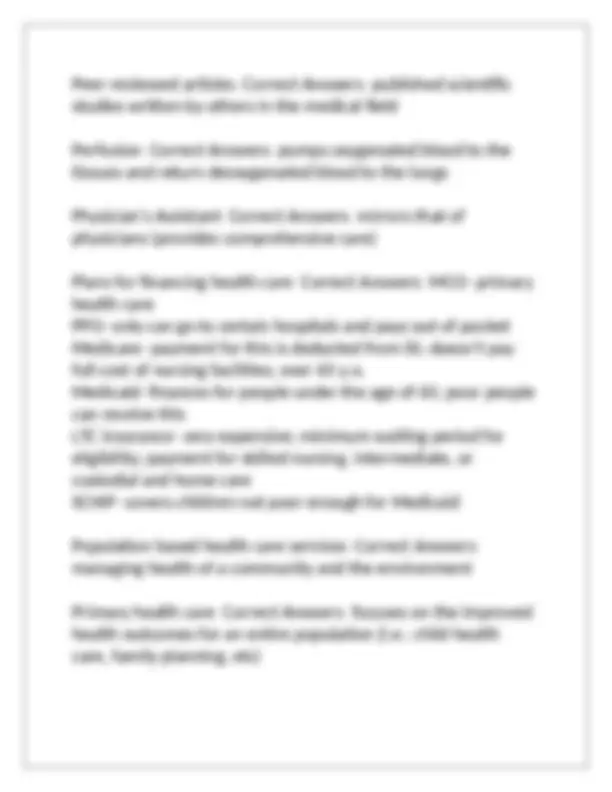
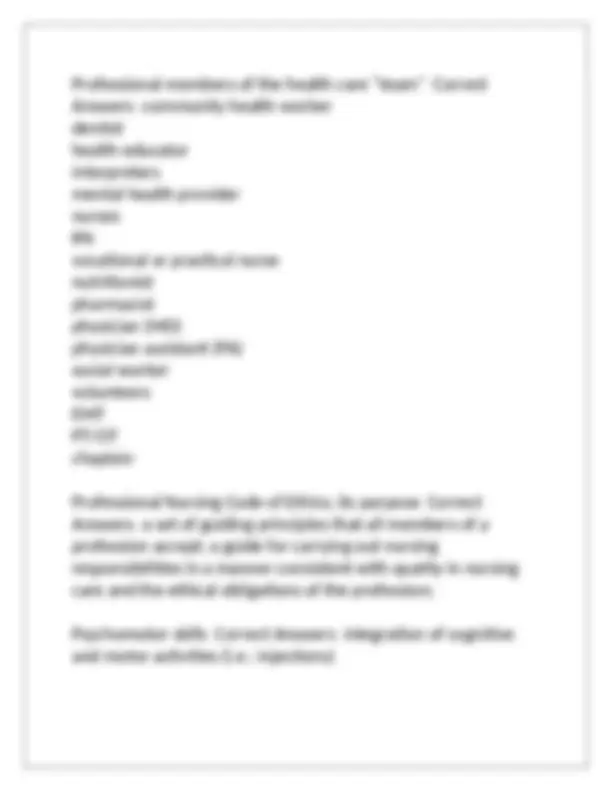
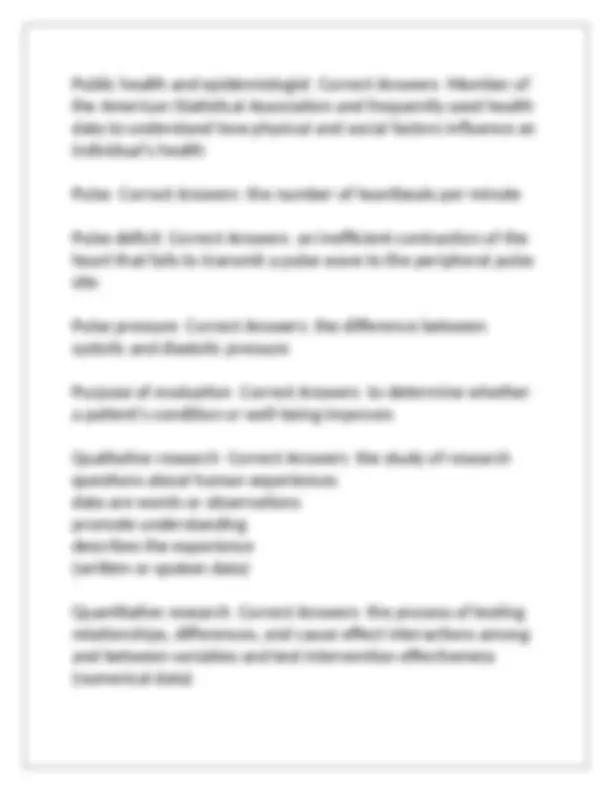
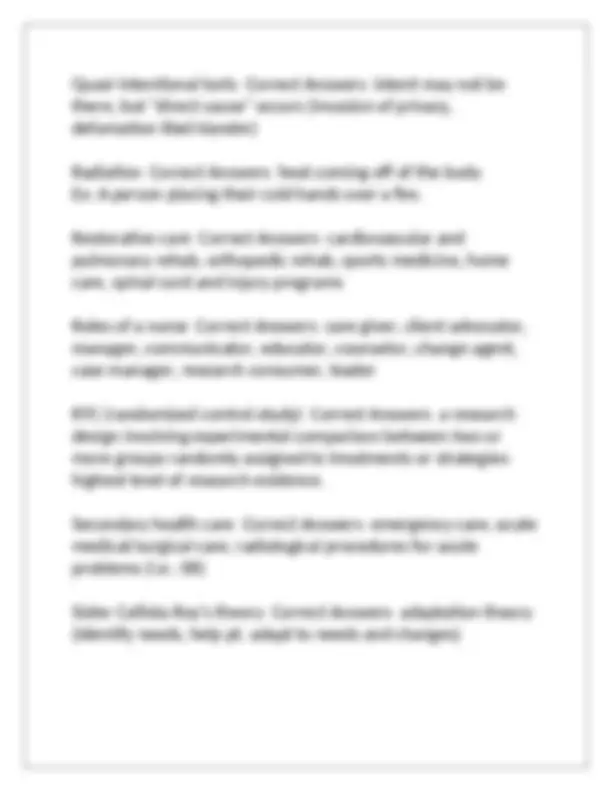
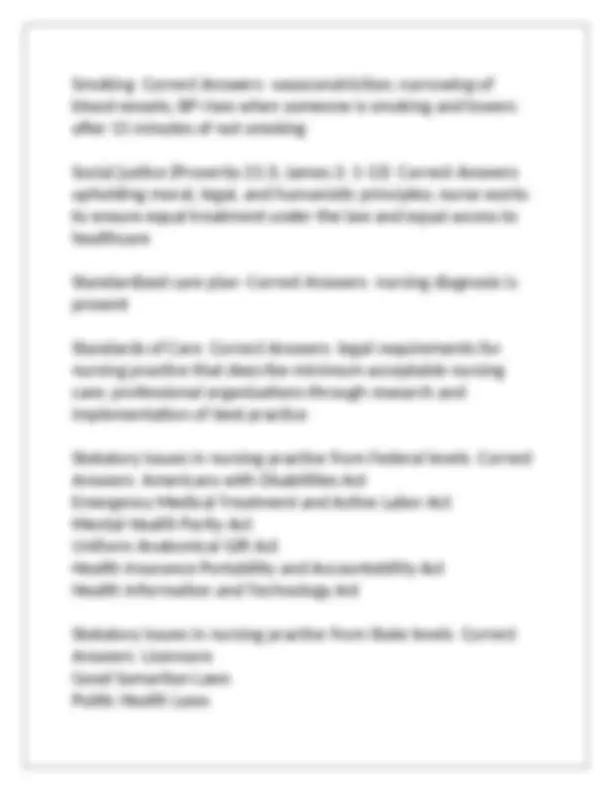
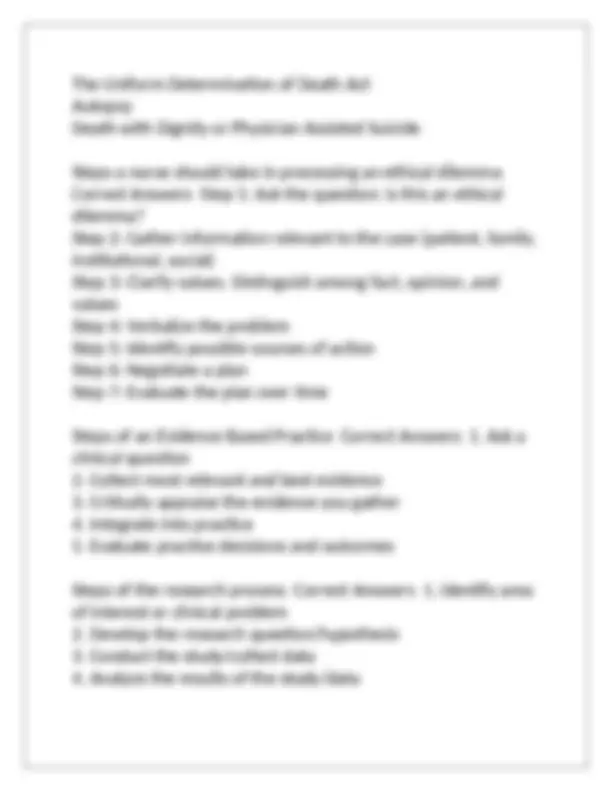
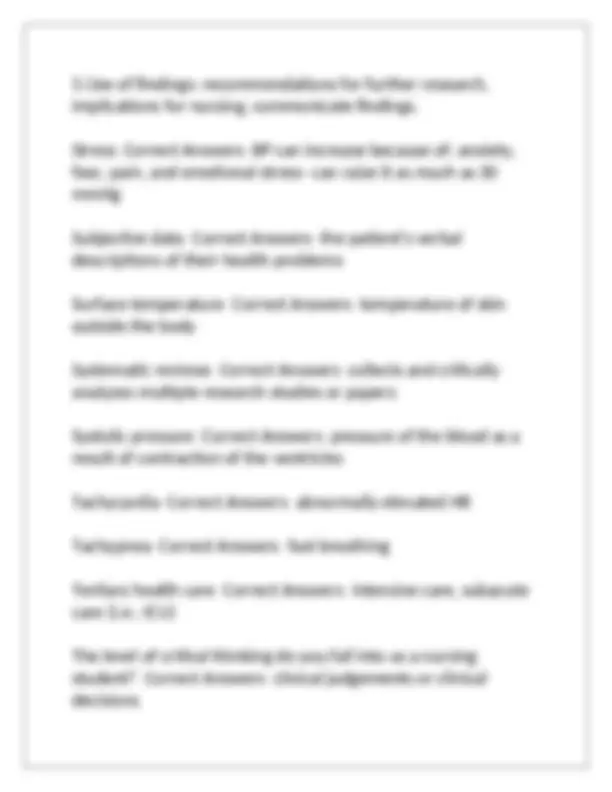
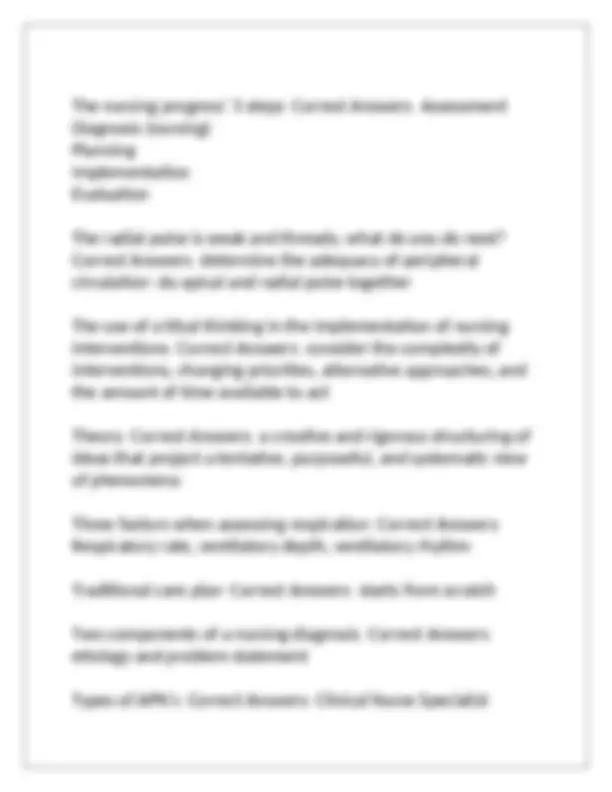
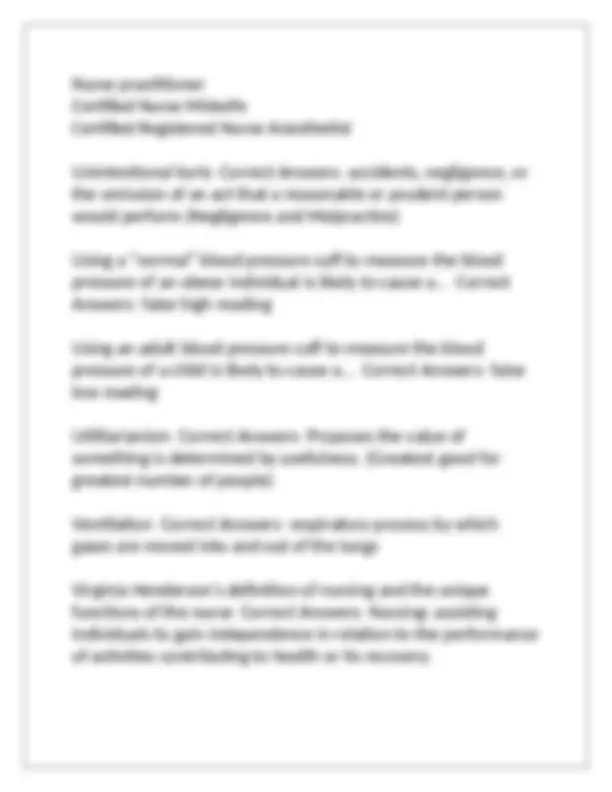
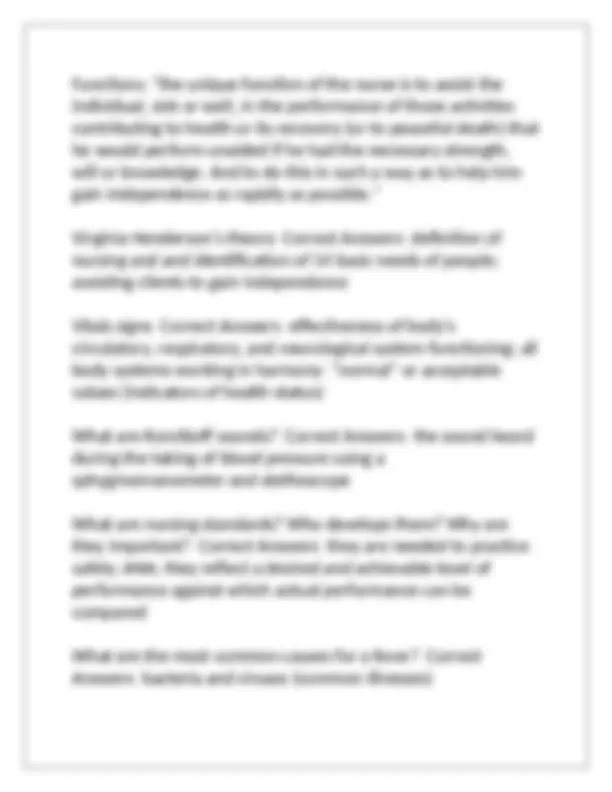
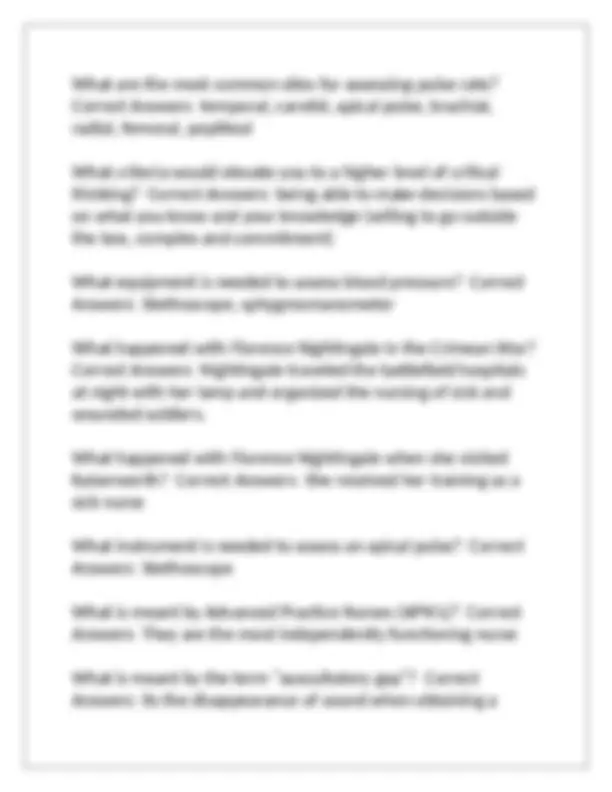
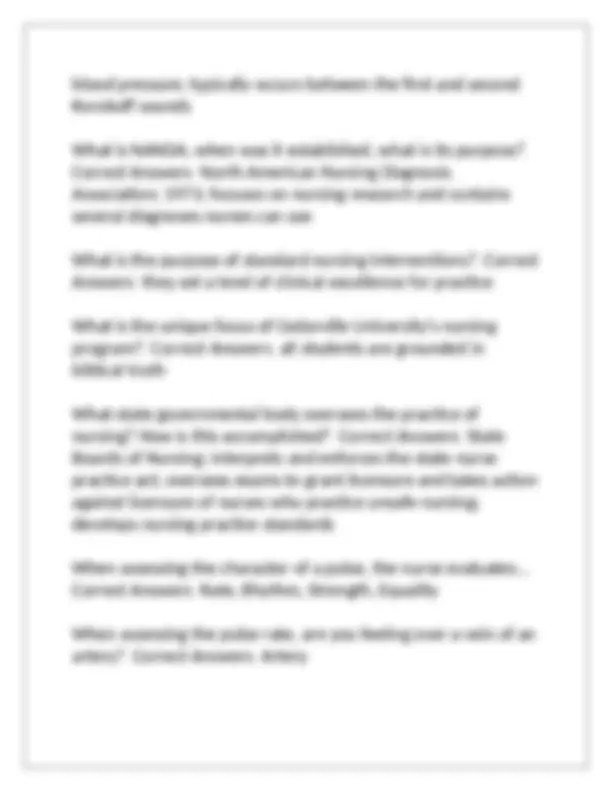
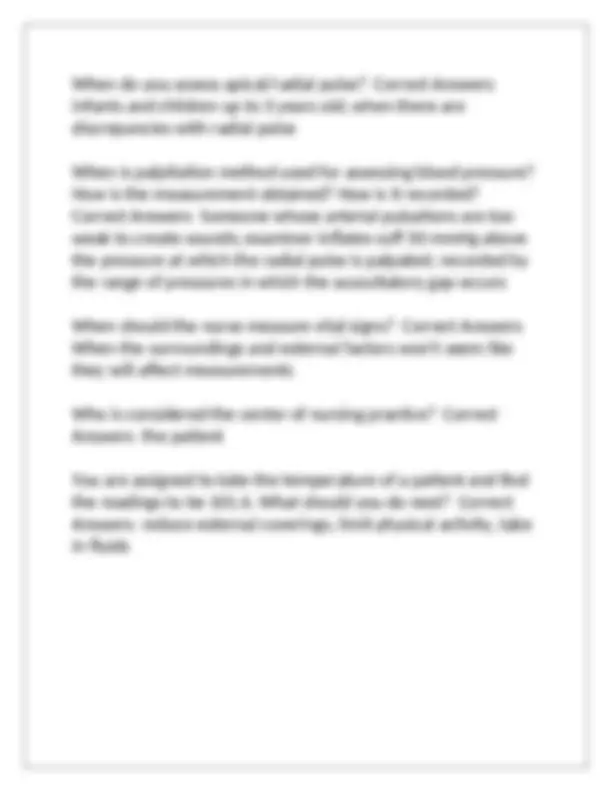


Study with the several resources on Docsity

Earn points by helping other students or get them with a premium plan


Prepare for your exams
Study with the several resources on Docsity

Earn points to download
Earn points by helping other students or get them with a premium plan
Community
Ask the community for help and clear up your study doubts
Discover the best universities in your country according to Docsity users
Free resources
Download our free guides on studying techniques, anxiety management strategies, and thesis advice from Docsity tutors
A comprehensive set of questions and answers for the nursing 1000 final exam at cedarville university. It covers a wide range of topics, including nursing theory, practice, and ethics. Organized in a question-and-answer format, making it easy to review and study. It is a valuable resource for students preparing for their final exam.
Typology: Exams
1 / 30

This page cannot be seen from the preview
Don't miss anything!























Nursing 1000 Final - Cedarville University Questions With Complete Solutions A concept map and how you utilize it Correct Answers a visual representation of patient problems and interventions that shows their relationships to one another; you utilize this by better synthesizing relevant data about a patient, including assessment data, nursing diagnoses, heath needs, nursing interventions, and evaluation measures; helps you better understand diagnoses with the data Afebrile Correct Answers when the fever breaks After collecting data through assessment, what are you going to do with it? Correct Answers Make a nursing diagnosis After evaluating, if the goals are met, you... Correct Answers discontinue the care plan After evaluating, if the goals are not met, you... Correct Answers modify the care plan (repeat the nursing process, include the patient in modifying the care plan) Age Correct Answers BP changes as you get older Altruism (Matthew 14:14) Correct Answers concern for the welfare and well-being of others; nurses concern for the welfare of patients, other nurses, and other health-care providers
ANA definition of nursing Correct Answers (American Nurses Association) The protection, promotion, and optimization of health and abilities, prevention of illness and injury, and alleviation of suffering through the diagnosis and treatment of human response and advocacy in the care of individuals, families, communities and populations. ANA definition of professional nursing Correct Answers "the protection, promotion, and optimization of health and abilities, prevention of illness and injury, facilitation of healing, alleviation of suffering through the diagnosis and treatment of human response, and advocacy in the care of individuals, families, groups, communities, and populations." Apnea Correct Answers absent breathing Arterial oxygen saturation; how its measured Correct Answers the amount of hemoglobin fully saturated with oxygen, given as a percent value; measured by a pulse oximeter-shines an LED on those hemoglobin molecules to calculate the pulse saturation Associate degree program (ADN) Correct Answers 2 years of school; focus on caregiver role as a nurse; very technical and psychomotor skill oriented; increase in patient morbidity or mortality; not qualified to advance in practice
Circadian (daily) variations Correct Answers it can be higher at certain times of the day: 10am-6pm; lower 12am-3am Circadian rhythm Correct Answers temperature variations over 24 hours Civil law Correct Answers deal with a violation of one individual's rights by another individual. Crimes are not committed. There is a dispute between individuals Clara Barton Correct Answers organized and founded the American Red Cross Classification priorities Correct Answers High-life threatening Intermediate-health threatening Low-developmental needs Clinical guidelines Correct Answers systematically developed statements about a plan of care for a specific set of clinical circumstances involving a specific patient population Cognitive skills Correct Answers critical thinking and decision making skills Collaborative interventions Correct Answers therapies that require the combined knowledge, skill, and expertise of multiple healthcare providers (i.e.: consulting with the discharge coordinator)
Collaborative problem Correct Answers an actual or potential physiological complication that nurses monitor to detect the onset of changes in a patient's health status Concept Correct Answers an idea, thought, or notion conceived in the mind Conduction Correct Answers Heat transferring from one thing to another Ex: A pot sitting on a burner. Convection Correct Answers Transfer of heat to something wet Ex: Putting your wet shoes on a floor vent to dry them faster. Core temperature Correct Answers temperature of deep tissues Criminal law Correct Answers concerned with providing protection for all members of society Critical pathway; who utilizes it? Correct Answers includes the assessment, interventions, treatments, and outcomes for specific conditions according to a timeline; nurses use them for the patient
Diastolic pressure Correct Answers pressure when the ventricles are at rest- the lower pressure that is present at all times within the arteries Difference between licensure and a nursing degree Correct Answers you need to apply for this in order to be an RN; you have this after graduation-pass the NCLEX-RN exam Diffusion Correct Answers the state or process of being widely spread Disease prevention Correct Answers blood pressure and cancer screenings, immunizations, mental health counseling, crisis prevention, community legislation Domain Correct Answers the perspective or territory of a profession or discipline Dorothea Dix Correct Answers recruited and supervised nurses for the Union Army Dorothea Orem's theory Correct Answers self care theory (Nurses increase the ability of the patient to care for self) Dyspnea Correct Answers sensation of shortness of breath Dysrhythmia Correct Answers an internal interruption by an early or late beat indicates an abnormal rhythm
Ethnicity Correct Answers African Americans tend to have a higher BP - can develop more severe hypertension Eupnea Correct Answers normal breathing Evaporation Correct Answers Water evaporating into a gas Ex: Water leaving the skin. Evidence based practice Correct Answers Taking research and applying the findings to improve practice. Use of current best evidence from nursing research, clinical expertise, practice trends, and pt. preferences to guide nursing decisions about care provided to pt. Febrile Correct Answers the hypothalamus set point drops, initiating heat-loss responses Fever (pyrexia) Correct Answers heat-loss mechanisms are unable to keep pace with excessive heat production, resulting in an abnormal rise in body temperature Fidelity Correct Answers the agreement to keep promises; faithful to commitments Florence Nightingale's theory Correct Answers environmental theory (manipulate environment to aid in healing)
How does critical thinking relate to assessment? Correct Answers It helps you ask the right questions to both the people you're talking to and about the data that has been collected How is blood pressure recorded? Correct Answers systolic/diastolic How would you assess for orthostatic hypotension? Correct Answers take all the normal vital signs, but at 3 different times: supine, sitting, and standing; 3 minutes apart Human dignity (Galatians 5:22-23) Correct Answers respect for the inherent worth and uniqueness of individuals and populations; the nurse values and respects all patients and colleagues Hypertension Correct Answers more common than hypotension; thickening of walls, loss of elasticity, unknown cause; family history, risk factors Hyperthermia Correct Answers an elevated body temp. related to the inability of the body to promote heat loss or reduce heat production Hypotension Correct Answers dilation of arteries; loss of blood volume; decrease of blood flow to vital organs; orthostatic/postural
Hypothermia Correct Answers heat loss during prolonged exposure to cold overwhelms the ability to produce heat Imogene King's theory Correct Answers goal attainment theory- focuses on communicational and interpersonal processes Independent nursing interventions Correct Answers actions that a nurse initiates without supervision or direction from others (i.e.: making a nursing diagnosis) Individualized care plan Correct Answers starts as standardized and then you put in the (R/T) statement as well as time limits for outcomes and specific instructions Integrity (Ephesians 4:15) Correct Answers acting in accordance with an appropriate code of ethics and accepted standards of practice; honest in all aspects of nursing Intentional torts Correct Answers the professional intends to do harm and does (assault, battery, false imprisonment) Interpersonal skills Correct Answers communication with patients Isabel Hampton Robb Correct Answers founded Nurses Association Alumnae of US and Canada (ANA)
Madeline Leininger's theory Correct Answers cultural care diversity and universality; transcultural care Malpractice Correct Answers improper, illegal, or negligent professional activity or treatment that harms another. Martha Rogers' theory Correct Answers science of unitary human beings- focus on energy fields Mary Mahoney Correct Answers first African American educated nurse Measurements included in assessing vital signs Correct Answers 1. Temperature
New roles that exist for nurses Correct Answers 1. Forensic nursing
Normal pulse rate for a newborn baby Correct Answers 120- 160 Normal range for blood pressure in an adult Correct Answers Systolic: <120 mmHg Diastolic: <80 mmHg
regarding scope of practice issues; State Board of Nursing for each state; protecting those we care for Nurse practitioner Correct Answers more of a holistic, multi- dimensional approach (collaborative relationship); focus more on health promotion, disease prevention, health education, attentiveness, and counseling Nursing accountability Correct Answers as a nurse, you are responsible professionally and legally for the type and quality of nursing care provided Nursing as a science Correct Answers Based on a body of knowledge that is continually changing with new discoveries and innovations. Nursing as an art Correct Answers Delivering care with compassion, caring, and respect for each patient's dignity and personhood. Nursing autonomy Correct Answers the initiation of independent nursing interventions without medical records Nursing diagnosis Correct Answers a clinical judgment concerning a human response to health conditions/life processes, or vulnerability for that response by an individual, family, or community that a nurse is licensed and competent to treat
Nursing theory and nursing practice relationship Correct Answers Theory is useful for demonstrating that although nursing is a practice discipline, it is also a profession with a body of knowledge Objective data Correct Answers the observations or measurements of a patient's health status Orthopnea Correct Answers abnormal condition in which a person must sit or stand in order to breathe comfortably Orthostatic hypotension Correct Answers when a normostatic person develops symptoms and a drop of systolic pressure by at least 20 mmHg or a drop in diastolic pressure by at least 20 mmHg within 3 minutes of rising to an upright position Other sources of assessment data in addition to the client Correct Answers 1. family and significant others
Professional members of the health care "team" Correct Answers community health worker dentist health educator interpreters mental health provider nurses RN vocational or practical nurse nutritionist pharmacist physician (MD) physician assistant (PA) social worker volunteers EMT PT/OT chaplain Professional Nursing Code of Ethics; its purpose Correct Answers a set of guiding principles that all members of a profession accept; a guide for carrying out nursing responsibilities in a manner consistent with quality in nursing care and the ethical obligations of the profession; Psychomotor skills Correct Answers integration of cognitive and motor activities (i.e.: injections)
Public health and epidemiologist Correct Answers Member of the American Statistical Association and frequently used health data to understand how physical and social factors influence an individual's health Pulse Correct Answers the number of heartbeats per minute Pulse deficit Correct Answers an inefficient contraction of the heart that fails to transmit a pulse wave to the peripheral pulse site Pulse pressure Correct Answers the difference between systolic and diastolic pressure Purpose of evaluation Correct Answers to determine whether a patient's condition or well-being improves Qualitative research Correct Answers the study of research questions about human experiences data are words or observations promote understanding describes the experience (written or spoken data) Quantitative research Correct Answers the process of testing relationships, differences, and cause effect interactions among and between variables and test intervention effectiveness (numerical data)